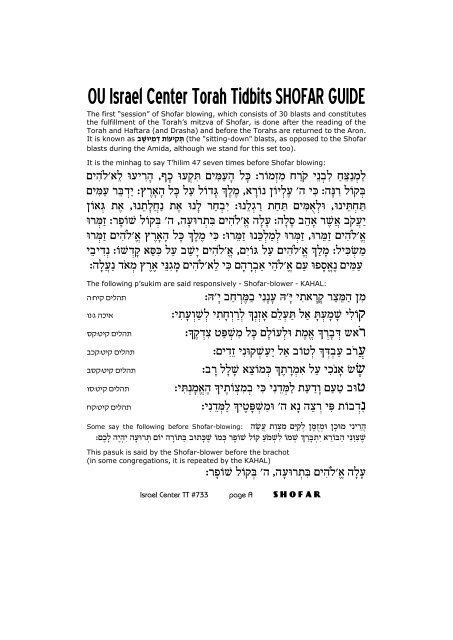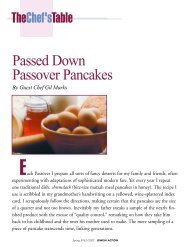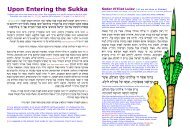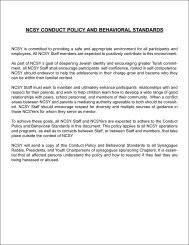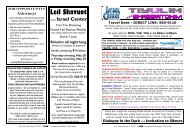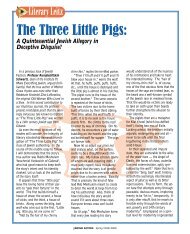OU Israel Center Torah Tidbits SHOFAR GUIDE
OU Israel Center Torah Tidbits SHOFAR GUIDE
OU Israel Center Torah Tidbits SHOFAR GUIDE
You also want an ePaper? Increase the reach of your titles
YUMPU automatically turns print PDFs into web optimized ePapers that Google loves.
<strong>OU</strong> <strong>Israel</strong> <strong>Center</strong> <strong>Torah</strong> <strong>Tidbits</strong> <strong>SHOFAR</strong> <strong>GUIDE</strong><br />
The first “session”of Shofar blowing, which consists of 30 blasts and constitutes<br />
the fulfillment of the <strong>Torah</strong>’s mitzva of Shofar, is done after the reading of the<br />
<strong>Torah</strong> and Haftara (and Drasha) and before the <strong>Torah</strong>s are returned to the Aron.<br />
It is known as a®WEinß c zFriwßY (the "sittingdown" blasts, as opposed to the Shofar<br />
blasts during the Amida, although we stand for this set too).<br />
It is the minhag to say T’hilim 47 seven times before Shofar blowing:<br />
midl'`•l Eri x®d ,s®k Er ßwY miO©r®d l®M :xFnßfn g© xw i•pßal ©g•S©pßn©l<br />
miO©r x•Aß c©i :u§ x®`®d l®M l©r lFc®B K§l§n ,`® xFp oFi ßl§r 'd iM :d®P x lFwßA<br />
oF`ßB z§` ,Ep•z®l£g©p z§` Ep®l x©gßai :Ep•lßb© x z©g©Y miO`ßlE ,Epi•Yßg©Y<br />
ExßO©f :x®tFW lFw ßA 'd ,d®rExßzA mi dl'°` d®l®r :d®l§q a•d®` x§W£` aw£r©i<br />
ExßO©f mi dl'°` u§ x®`®d l®M K§l§n iM :Ex •O©f Ep•Mßl©nßl ExßO©f ,Ex•O©f mi dl'°`<br />
i•ai cßp :FWß c®w `•QM l©r a©W®i midl'°` ,miFB l©r midl'°` K©l®n :liMßU©n<br />
:d®l£r©p c`ßn u§ x§` i•Pb®n midl'`•l iM m®d® xßa©` i•dl'°` m©r Et®q°`§p mi O©r<br />
The following p’sukim are said responsively Shofarblower KAHAL:<br />
d:giw mildz<br />
ep:b dki`<br />
qw:hiw mildz<br />
akw:hiw mildz<br />
aqw:hiw mildz<br />
eq:hiw mildz<br />
gw:hiw mildz<br />
Some say the following before Shofarblowing:<br />
:D'®i a©gß x§O©a ip®p®r D'®I iz`® x®w x©v•O©d on<br />
:iz®rß e©Wßl iz®gß e© xßl Lßpßf®` m•lßr©Y l©` ®Yßr®n®W ilFw<br />
:L§wß cv h©RßWn l®M m®lFrßlE z§n°` Lß x®aß C y`x<br />
:mi c•f ipEwßW©r©i l©` aFhßl Lß Cßa©r ax £r<br />
:a® x l®l®W `•vFnßM L§z® xßn` l©r ikp®` U ®U<br />
:iYßp®n°`§d Li §zFßvnßa iM ip•cßO©l z©r©c®e m©r©h aEh<br />
:ip•cßO©l Li §h®RßWnE 'd `®p d•vß x iR zFacß<br />
d•U£r z©eßvn m•I©wßl o®OfßnE o®kEn ipi• x£d<br />
:m§k®l d§ißdi d®rExßY mFi d xFY©A ® aEz®M§W FnßM x®tFW lFw ©rnßWl FnßW K© x®Aßzi `• xFA©d ip©ES§W<br />
This pasuk is said by the Shofarblower before the brachot<br />
(in some congregations, it is repeated by the KAHAL)<br />
:x®tFW lFw ßA 'd ,d®rExßzA mi dl'°` d®l®r<br />
<strong>Israel</strong> <strong>Center</strong> TT #733 page A <strong>SHOFAR</strong><br />
p
The Shofarblower AND each person listening to the Shofar should have KAVANA<br />
during the BRACHOT to fulfill the mitzva of Shofar, both the <strong>Torah</strong> requirements<br />
and those of our Sages. One must be careful to hear the entire BRACHOT<br />
without interruption, and to answer AMEN to each.<br />
It is proper not to talk (other than davening and what is necessary for davening<br />
and Shofar) from the BRACHOT through the last of the blasts (after the<br />
repetition of the Musaf Amida), but especially until the first set of 30 KOLOT are<br />
completed. Although there are Machzorim that have passages for the KAHAL to<br />
say after each trio of sounds, it is widely accepted for the KAHAL to remain<br />
silent throughout the set of 30 blasts.<br />
,m®lFr®d K§l§n Epi•dl'°` ,'d d®Y©` KEx®A<br />
:x®tFW lFw ©rFnßWl Ep®Evß e ,ei ®zFßvnßA Ep ®WCw ß x§W£`<br />
:d§G©d o©nßG©l Ep®riBdße Ep ®nßIwße Ep®i°g§d§W ,m®lFr®d K§l§n Epi•dl'°` 'd d ®Y©` KEx®A<br />
:driwz .drexz-mixay .driwz<br />
:driwz .drexz-mixay .driwz<br />
:driwz .drexz-mixay .driwz<br />
:driwz .mixay .driwz<br />
:driwz .mixay .driwz<br />
:driwz .mixay .driwz<br />
:driwz .drexz .driwz<br />
:driwz .drexz .driwz<br />
:(dlecb) driwz .drexz .driwz<br />
After the T’KI’OT D’M’YUSHAV, the following p’sukim are said<br />
responsively Shofarblower KAHAL, as an introduction to ASHREI<br />
fh:ht mildz<br />
fi:ht mildz<br />
gi:ht mildz<br />
Back to the Machzor for ASHREI...<br />
:oEk•N©dßi Li§p®R xF` ßA 'd ,d®rExßz i•rß cFi m®r®d i• xßW©`<br />
:EnEx®i Lßz®wß cvßaE ,mFI ©d l®M oElibßi LßnWßA<br />
:Ep•px©w ß mEx ®Y LßpFvß xaE ,d®Y®` Fn®Gr z§ x§`ßtz iM<br />
:d®l§q LElßl©dßi cFr ,L§zi•a i•aßWFi i xßW©` •<br />
<strong>Israel</strong> <strong>Center</strong> TT #733 page B <strong>SHOFAR</strong>
The Mitzva to Hear Shofar<br />
First and foremost, before any of the<br />
themes, symbolisms, and reminders<br />
mentioned in the paragraphs that follow,<br />
is the main reason and kavana for doing<br />
ANY mitzva because Gd commands it.<br />
The phrase L'SHEIM MITZVAT <strong>SHOFAR</strong><br />
should be on our minds from the Brachot<br />
of the shofarblower, from the first blast<br />
to the 100th.<br />
The <strong>Torah</strong> says that the first day of the<br />
seventh month shall be a T'RU'A DAY.<br />
We are taught by the Oral Law that this<br />
means that we are to hear the sound<br />
called T'RU'A, which is to be produced by<br />
the Shofar. Furthermore, we are to hear<br />
the T’RU’A three times, and that each<br />
T’RU’A is to be preceded by and followed<br />
by a P'SHUTA, a plain, long blast, the<br />
one we call T'KI'A.<br />
We do not know exactly what our Sages<br />
meant the T'RU'A to sound like. It is to<br />
sound like crying, wailing, sobbing,<br />
moaning, sighing, or some combination<br />
thereof. To satisfy different opinions, we<br />
have two sounds that we call SH'VARIM<br />
and T'RU'A, and the combination of the<br />
two. Therefore, to satisfy the <strong>Torah</strong>'s<br />
requirement of hearing the Shofar on<br />
Rosh HaShana, we must hear 3 each of<br />
the following combinations:<br />
T'KI'A | SH'VARIMT'RU'A | T'KI'A<br />
T'KI'A | SH'VARIM | T'KI'A<br />
T'KI'A | T'RU'A | T'KI'A<br />
Let’s refer to this as a Large Set of Blasts<br />
(a.k.a. 30 KOLOT). One of each make a<br />
Small Set (a.k.a. 10 KOLOT).<br />
Although the requirement of the <strong>Torah</strong><br />
will be satisfied with 30 KOLOT (sounds<br />
or blasts), the Sages instituted the<br />
practice of sounding the Shofar during<br />
the Amida linking the Shofarsounds<br />
with each of the 3 main brachot of Musaf<br />
MALCHIYOT (Kingship), ZICHRONOT<br />
(Remembrances), and <strong>SHOFAR</strong>OT<br />
(Shofars). Some shuls blow during the<br />
repetition of the Amida only; others blow<br />
during the silent Amida as well.<br />
And, as is wellknown, the custom is to<br />
blow additional blasts (10 or 40, as the<br />
case may be) after the Amida, to bring<br />
the total number of blasts to 100. 100<br />
conveys completeness and fullness. On<br />
Rosh HaShana, we don't just blow the<br />
Shofar, we are fully saturated with the<br />
Shofar sounds. This fulfills the sense of<br />
"YOM T'RU'A there shall be for you",<br />
more than a lesser number would.<br />
(There is also another reason given for<br />
the 100 blasts, having to do with the<br />
lament of the mother of Sisra, as<br />
recorded in the Book of Sho'f'tim.)<br />
Symbolisms and Kavanot<br />
(based on Menorat HaMa'or)<br />
GD'S KINGSHIP<br />
Rosh HaShana corresponds to the 6th<br />
day of creation, the day human beings<br />
were created. Since it is the day that<br />
Gd's subjects, so to speak, came into<br />
existence, it follows that He became King<br />
on that very same day. We therefore<br />
consider Rosh HaShana to be the<br />
Coronation Day of the Supreme King. To<br />
herald that event, we sound the royal<br />
trumpet the Shofar. This concept of<br />
Gd's Kingship is one of the major<br />
themes of Rosh HaShana. One of the<br />
three central brachot of the Rosh<br />
HaShana Musaf is Malchiyot Kingship.<br />
In that bracha, we quote ten p’sukim<br />
from Tanach that deal with this theme.<br />
The T'KI'A (the long monotonic,<br />
unbroken blast) specifically is associated<br />
with this aspect of Rosh HaShana. The<br />
T'KI'A is a happy and proud sound.<br />
Although other emotions claim our<br />
attention, one should be happy and<br />
proud on Rosh HaShana as we reaffirm<br />
our loyalty to the King of Kings.<br />
CALL TO REPENTANCE<br />
The Shofar is the alarm that (hopefully)<br />
wakes people up to the challenge of<br />
doing T'shuva and asking Gd for<br />
forgiveness. This is one of the major<br />
aspects of Shofar (and the main reason<br />
<strong>Israel</strong> <strong>Center</strong> TT #733 page C <strong>SHOFAR</strong>
for having blown the Shofar throughout<br />
Elul). It is the broken sounds of the<br />
SH'VARIM and T'RU'A that most fit this<br />
aspect of Shofar. Shofar is associated<br />
with embarking on the road to Spiritual<br />
Return.<br />
AKEIDAT YITZCHAK<br />
Perhaps the most prominent element of<br />
Rosh HaShana is the Binding of Isaac.<br />
The choice of a ram's horn as Shofar, the<br />
<strong>Torah</strong> readings, the main focus of the<br />
Zichronot bracha, and Tashlich, all point<br />
to the AKEIDA as a major theme of the<br />
day. When we stand in judgment before<br />
Gd, we are not isolated individuals but<br />
are the spiritual heirs of the Avot and<br />
Imahot whose commitment to Gd is<br />
exemplified by the Akeida. The Chafetz<br />
Chaim points out that most of the<br />
promises of blessing in the <strong>Torah</strong> are<br />
conditional upon our good behavior. The<br />
notable exception is Gd's promise to<br />
Avraham Avinu at the Akeida, which is<br />
unconditional. If our sincerity and<br />
commitment to Gd and His Mitzvot ever<br />
comes into question, we need only<br />
realize that we are the descendants of<br />
Avraham & Yitzchak and have inherited<br />
from them an absolute and complete<br />
dedication to Gd's Word, the <strong>Torah</strong>.<br />
MATAN TORAH<br />
The <strong>Torah</strong> describes the events of Sinai<br />
as being accompanied by the "sound of<br />
the Shofar ever increasing". When we<br />
hear the Shofar (specifically the T'KI'A),<br />
we should be motivated to rededicate<br />
ourselves to <strong>Torah</strong> and mitzvot. In<br />
essence, this is the foundation of<br />
T'shuva. The Shofar reminds us of our<br />
commitment to the <strong>Torah</strong>; repentance is<br />
Gd's gift to us when we fail in that<br />
commitment.<br />
The words of the Prophets<br />
are likened to the sound of the Shofar.<br />
This reminder should inspire greater<br />
commitment to faithful observance of<br />
Judaism. Our deal with Gd, when we<br />
asked not to hear His voice directly, was<br />
our promise to listen to the prophets,<br />
starting with Moshe and continuing<br />
throughout the generations. This aspect<br />
of Shofar, then, follows the previous<br />
item Matan <strong>Torah</strong>.<br />
INSTILLS FEAR<br />
"If a Shofar sounds in the city, will not<br />
the People tremble?" Think of the sound<br />
of a siren the feelings of apprehension<br />
and dread that it filled us with. That's a<br />
Shofar our spiritual siren, helping us to<br />
get serious about <strong>Torah</strong> and T'shuva.<br />
Churban Beit HaMikdash<br />
should also be kept in mind while<br />
hearing the Shofar. The Prophets<br />
mention the Shofar in their description of<br />
the Churban. One should think of the<br />
"ups and downs" of Jewish history as<br />
part of the Rosh HaShana challenge that<br />
we all face. Furthermore, the destruction<br />
of the Temples resulted from our not<br />
keeping faith with Gd. These thoughts<br />
then, should also lead us to think of<br />
repentance as the way to reverse the<br />
devastating effects of the Churban.<br />
Ingathering of the Exiles<br />
is described by Yeshayahu as being<br />
accompanied by the sound of a Great<br />
Shofar. We are witness to the beginning<br />
of that process; may we be privileged to<br />
see its continuation and culmination.<br />
This too is in the realm of the T'KI'A and<br />
is one of the promises to keep in mind so<br />
that we can put "things in proper<br />
perspective".<br />
The Great Judgment Day is<br />
associated with the Shofar. One must<br />
understand that we stand in judgment<br />
before Gd on every Rosh HaShana, but<br />
that we we will also do so on a different<br />
scale "after 120 years" and "at the end<br />
of days".<br />
T'CHIYAT HAMEITIM is also<br />
associated with Shofar. Thinking of this<br />
gives us a broader perspective on what<br />
Gd expects of us and what is in store.<br />
<strong>Israel</strong> <strong>Center</strong> TT #733 page D <strong>SHOFAR</strong>


